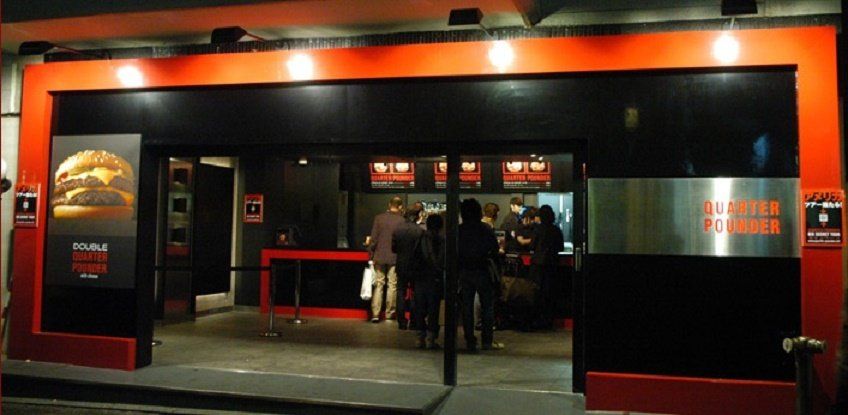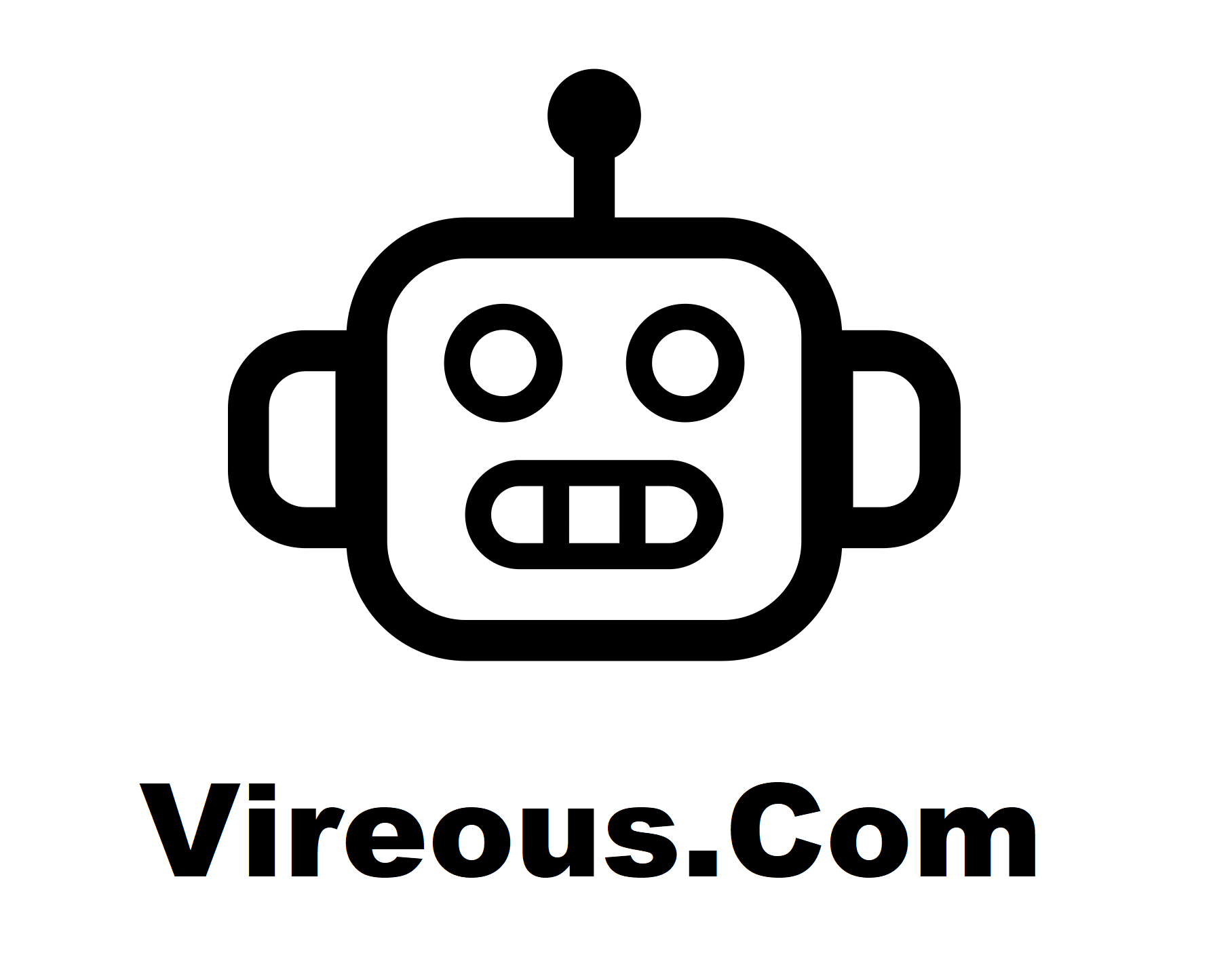
Today, when a big company buys a little one, it hopes that nobody notices. The aim is to keep the indie feel of the niche brand, while applying the distribution and marketing advantages of the big acquiring firm.
The marketing behind niche brand experiments like the Absolut Vodka 'Cities' series designed by local artists, or the McDonalds 'Quarter Pounder' stores in Japan or the Adidas Originals raises interesting questions about how brands can go into their consumer sub-groups for new connections.
Part of a limited-time promotion, two McDonald's stores in fashionable Tokyo neighbourhoods were remodeled and reopened as unbranded Quarter Pounder shops as part of the fast food chains expansion in Japan. The minimal black and red shops (pictured) featured Le Corbusier sofas and only two menu items: the Quarter Pounder with cheese meal or Double Quarter Pounder with cheese meal. Extending the motif, all food was served in solid red packaging with black block lettering.
Similarly, car companies are also taking niche input onboard and individual customers are joining the experts in new product design for the first time.
Microsoft and Dodge for example teamed up to get people excited about the Dodge Challenger R/T by commissioning an online design competition where contenders could customize a Dodge Challenger to their own liking. Dubbed 'Dream Design Drive Challenge', the 300,000 entrants were able to use a variety of tools to customize the car's paint scheme, layout and detailing to make the car as unique as possible.
Other examples of some niche brand activations include mass-volume brands partnering with high-end designers to create limited-edition products or capsule ranges, such as Adidas and Stella McCartney, H&M and Alexander Wang, and Diet Coke's multiple-year strategy of partnering with Karl Lagerfeld, Jean Paul Gaultier and Marc Jacobs.
Indeed, one
of the most interesting branding trends as we look ahead is
the relationship between the society of tomorrow and business. Brands
are fundamentally changing in a world where the consumer is
overloaded with information. Customers are being turned off by the
white noise of advertising, meaning that brands will be forced
to become bolder, sharper and more inventive to stay relevant. In an
age of globalization and access to brands on a massive scale,
consumers want to feel individual and special again.
Part of
this change is the ‘Long Tail’ and the effect of the digital
economy which is bringing economies of scale to ever-more obscure and
niche products, and bringing them to market in a way that wasn’t
possible before. More on the Long Tail later.
Niche
activations in action
The goal for the brand owner to stay connected is to take a broad category (whether computers, vodka, burgers, shoes or cars) into a niche and to make it work. Can something generic be made to appeal to specific age, gender, ethnic or lifestyle group (micro niches) whilst also existing as a single mass entity?
The Food Channel website in the US manages to appeal to a wide range of people through targeted niche programming. Through its multimedia programming, The Food Channel manages to specifically define shows that appeal to just about every conceivable age group, gender, ethnic group, cooking style, type of food, consumer interest.
To understand how to define your own niche, just look at some of their niches in foods: older women and those who love comfort food (Ree Drummond); home bakers (Anna Olson); Asians (Ching-He Huang); African Americans (Siba Mtongana); manly men (Guy Fieri); food nerds (Alton Brown); and back in the day, the young and laid-back (Jamie Oliver).
The company has been incredibly innovative at taking a broad general category, that could be boring or routine, and turning it into much more by carving out narrow niches.
A niche by definition is narrow. It will not appeal to everyone. But if a brand has captured a niche properly, those in the niche will instantly recognize it. Possibly the one unifying concept of The Food Channel that makes it so successful is that it could probably serve as the template on how to use all multimedia elements successfully in bringing niche information to different groups.
Nike doesn't mention
that Converse is a subsidiary and Converse marketing doesn't mention
Nike. If people knew that Converse was a division of Nike it wouldn't
be as cool.
BMW goes to great lengths to keep the Mini
identity as a very separate personality. One alternative would have
been to reposition Mini as the BMW 0-Series and yet by its
positioning Mini is one of the few marques to be successful in the
premium, small car niche. Much of Mini’s marketability is wrapped
up in its history and image. Minis are cheeky, while BMWs are
teutonically not cheeky. Moreover, the Mini brand – under
guidance from Interbrand – is being expanded, so the number of
units sold is continuing to rise.
When small meant cheap, Mini and BMW set about defining the niche of compact luxury.
Dell has enabled
customers to customize a laptop cover with their own design and with
their own embossed sticker. New technology enables customers to see
their design before purchasing it. The world’s number three PC
maker says this two-way relationship gives Dell strong consumer input
which is critical to the company’s ethos of personalization.
According to Dell, its customers are less interested in the
exact technical description of their PC – although they have plenty
of options here too – but they are very interested in the feeling
of being able to customize and being given personal attention.
The 130-year-old Eastman Kodak - now Kodak Alaris for personalized imaging and document imaging - has also made big strides evolving into new niches. It has been very successful in using its brand name as a base to move wholeheartedly into the digital space coupled with aggressive marketing into new product areas. Since its core photographic film business faded, the former corporate icon has been remaking itself into a digital-photo and printing company, selling consumer ink-jet printers and high-speed commercial presses.
The US group has been seeking out a new, hipper image, through effective use of social media and it now has over 70 employees who regularly blog (including international bloggers).
A spokesperson says the blogs give Kodak a human face and allow customers to get the 'who', not the 'what', and that human face is really what people want to hear and see.
Kodak Alaris has its own production studio, so doing podcasts became a natural extension of its marketing efforts. Just this month Kodak Alaris has relaunched the Kodak Moments app with a new focus on photographic storytelling.
Also think of burger bling and the US$200 burger from Burger King that was trialed a while back as ‘The Burger’, raising funds for the Help a London Child charity. You could call it brand dis-synergy.
Using information tunnels
“We are seeing
everyone going toward niches and customization and this makes the
product accessible. People feel they want to be different,”
comments futurist, author and CEO of The Futures Agency, Gerd
Leonhard.
Referring to the Dodge design example, Leonhard predicts that cars will increasingly become social objects, whether owned or time-shared and self-driven, onto which we can apply our own personality. He believes that with the new personalized media world, niche items can be more successful in the marketplace, and this is a change that applies not only to digital products (non tangible goods like music, media or financial services) but also physical products.
Judging from his work for leading brands such as Nokia and Sony, Leonhard – also author of 'The Future of Music' and a new book ‘Friction is Friction: The Future of Content, Media & Business’ - says that companies need to embrace this aspect of social design and the connectivity the web brings into every aspect of our daily lives.
Through emerging technologies such as cloud computing and the Internet of Things, in the next five years 75% of the whole world will be connected.
"There are many great things about this, and there are many challenges about this," he says. "Our world is going to change more in the next 20 years than the previous 300 years."
By 2030, roughly 40% to 60% of all jobs will be completed by machines and aided by some form of robotics or automation, from financial advice to serving drinks.
Areas such as finance, real estate, medicine, energy and food are still to be "disrupted" in the way other industries, such as media, telecommunications and transportation, have in recent years, he says.
He talks about a future where blogs will be
record labels and bloggers will be the new music moguls. To an
increasing degree brands will be able, through technology, to address
us as niche groups and down to the level of the individual.
Completely
targeted and personalized advertising, delivered largely on totally
customized mobile computing and communication devices, will turn the
US$1 trillion advertising and marketing services economy upside down.
"Behavioural targeting and user-controlled advertising
will, of course, become an even hotter potato and a much discussed
challenge," says Leonhard. But he says the old deal for consumers of 'I give you
attention and personal data and you give me content' will become even
more pronounced on the web.
In fact, some are predicting that
mass advertising as we knew it is already more or less outmoded and
will, during the next few years, be completely reinvented.
Using information tunnels effectively, means that a brand can divide all recipients of content into ever-smaller groups - but these don't have to be socio-based or demographically based. Leonhard says that dividing people by age or income, or voting pattern, is less important. It's why they interact with you, their intention as individuals, that counts.
The success of Kodak is a case study on using social networking to maximize and apply marketing into new niches. Different marketing tactics operate at different points in the cultivation of customers, building up goodwill and the brand's reputation in the minds of its customers. To change people's brand beliefs and have greatest impact on their digital camera purchase decision, Kodak had to do a different kind of marketing than when it simply was trying to raise brand awareness.
Kodak Moments has over 700,000 fans on Facebook and 140,000 followers on its Kodak Alaris (Kodak Moments)Twitter handle. It offers a Facebook application that allows users to create photo albums, send messages and share pictures. Such ‘social shopping’ was recently identified as one of the hottest trends on Facebook
The increased
transparency and the wave of information coming at us from the online
world means that increasingly marketers have to ‘tunnel’
information and give us packets of information that are suitable for
our personal niche.
Some brands react by trying to send us
even more products and even more information, so that each one has a
‘scatter-gun’-ish opportunity to reach a target audience. But
increasingly there is evidence that our brains work best when our own
individual needs are satisfied and information is channeled to us
personally. The research shows that most people feel overloaded with
information online when they are presented with just ten choices.
Focused information often uses information tunnels. Communication is focused when it's precisely adjusted to a certain group of recipients. When a transmitter adjusts a certain message to several groups of recipients, and allow the individual recipient to choose which group she belongs to, the transmitter has created an information tunnel
The Long Tail and the real economy
In his book ‘The Long Tail’, Chris Anderson, entrepreneur and curator of the TED Talks, shows how “our culture and economy is increasingly shifting away from a focus on a relatively small number of ‘hits’ (mainstream products and markets) at the head of the demand curve and toward a huge number of niches in the tail.”
In the theory of the Long Tail according to Anderson, as the costs of production and distribution fall, especially online, there is now less need to lump products and consumers into one-size-fits-all containers. In an era without the constraints of physical shelf space and other bottlenecks of distribution, narrowly-targeted goods and services can be as economically attractive as mainstream concepts.
When we look at niche examples like the Quarter Pounder store and limited edition cars, vodka or sneakers, are they about personalization? Or is it part of a wider trend of brands spinning off into subsets of themselves? Why do niche brands win? Is this about consumers frantically searching for authenticity? Why are niche brands hot at the moment?
Some people would say that all strong brands are niche brands. But increasingly big brands are hoping some of the variety, assortment and the offbeat nature of small brands will rub off on them. History also dictates that brands will broaden and then contract, broaden and then retract, and so on, over and over again.
Gerd Leonhard says that essentially what is happening is that everyone wants to get closer to the customers, or as some would say "people formerly known as consumers."
Niche initiatives give a lot of momentum to the mainstream product. We are living in the era of science and technology, new research, applications, software, and discovery. And everyone wants to keep updated on these things. Therefore, every consumer remains in search of the 'new' and latest ideas.
|
Get in touch
|
|

